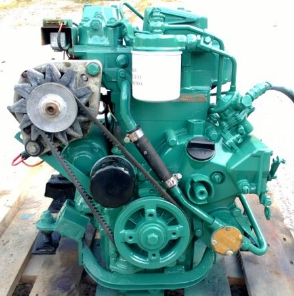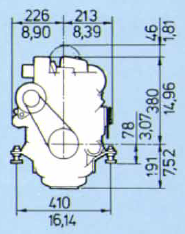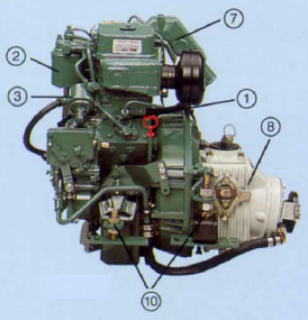
Volvo Penta 2001 Marine Diesel Engine

The Volvo Penta 2000 series of Marine Diesel engines were introduced in 1983, with the last engines produced in 1993. The Volvo Penta 2001 marine diesel engine had a cylinder displacement of 430cc and delivered 9 hp.
The 2000-Series was a complete engine programme from Volvo Penta, which had been specially developed for powering sailboats and small motor boats. In addition, there was a comprehensive accessories programme for the 2000-Series for other requirements, such as, heating, cooling, electricity etc. Directly injected, they were easily started and fuel-efficient marine diesels. Also, a large flywheel, decompression and cold-start facility which made cold starts easier. A 12-volt two terminal marine electrical system and AC alternator of 50A assured excellent charging and the engine was carried in vibration-damping rubber mounts providing a low noise level for the time.


The 200x series were the last marine diesel engine blocks to be designed and manufactured by Volvo themselves. While there are some generic components on the 200x series engines such as fuel system and electrics, the rest of the engine was made completely by Volvo and consequently spares are only available from Volvo. For an engine, they were made in vary small numbers compared to other industrial based engines and have now been out of production for over 25 years. Unfortunately, spares are starting to get scarce and expensive, particularly as many are now being scrapped and replaced with modern engines.
How heavy is the Volvo Penta 2001?
The different models of the Volvo Penta 2001 weigh between 112 kg (247 lbs) and 126 kg (260 lbs). The standard 2001-R/L weighs 112 kg (247 lbs). The 2001-V (with the additional reverse gear weighs 118 kg (260 lbs) and the 2002-S complete with sail drive leg weighs 126 kg (278 lbs). Lubricating oil, coolant and any alternator upgrades will add to this weight.

Specifications of the Volvo Penta 2001
| Volvo Penta 2001 | |
|---|---|
| Number of Cylinders | 1 |
| Idle (no-load) speed (rpm) | 850 |
| Full load speed (rpm) | 3200 |
| Cylinder Diameter (mm) | 79 |
| Stroke (mm) | 87 |
| Displacement | 430 cc |
| Power Output (hp) | 9 hp |

Dimensions of the Volvo Penta 2001



Video: Click to watch a short video of the Volvo Penta 2001 running



Components of the Volvo Penta 2001

- Fuel Filter
- Feed Pump
- Impeller Pump
- Oil Filler
- Oil Filter
- Engine Tie Rod

- Injection Pump
- Fuel Filter
- Feed Pump
- Water-cooled exhaust elbow
- R-reverse Gear
- Adjustable Flexible Engine Mounts


Maintenance jobs for your Volvo Penta 2001
- Changing the primary fuel filter on your marine diesel installation
- Checking the starter motor drive belt on your Volvo Penta 2001
- Removal and inspection of the air filter on the Volvo Penta 2001
Winterising jobs for your Volvo Penta 2001
Before haul-out:
- Volvo Penta 2001 engine oil and filter change
After haul-out:
- Flushing salt-water from the Volvo Penta 2001 and introducing anti-freeze
- Clean and winterise the raw-water filter
Before launch:
- Stern gear: Grease your lip seal or refill the greaser on your stuffing box
- Changing the Secondary Fuel filter on the Volvo Penta 2001
- Removing and testing the thermostat on your Volvo Penta 2001
After launch:


Some problems are common between lots of diesel engines – see our checklist of the most common faults. If you’re seeing smoke from your exhaust, read this. But every variant of engine has its own idiosyncratic “personality” so we’ve gathered together a list of the common faults for the 2001.
Having difficulty starting – follow the ‘cold start’ procedure
If you’re having trouble starting your 2001 in lower temperatures, then maybe you’re not following the recommended cold-starting routine. It seems odd but the following is the correct starting procedure. It actually engages a mechanical cold-starting mechanism in the engine.
- Advance the speed control to about half out of gear
- Pull the stop handle to the full extent of its travel and then push back to normal setting
- Start the engine
- When the engine is running, reduce the revs back down to idle
Engine overheating
As the 2001 engines are raw water cooled, they can get bunged up inside. The symptoms of this is overheating after an about an hour or so running under load. Happily, the cure is easy. Worth checking before you begin, though, is that the engine thermostat is operating correctly.
Technical Detail: The engine thermostat on the 2001 begins opening at 60±2°C / 140±4°F and should be fully open at 75°C / 165°F
There’s a pipe that carries cooling water from the front of the block to the back. Water runs continuously through this pipe from the water pump at the front of the engine through the pipe and then up into the exhaust elbow at the back. The pipe has a hole in it. When the engine gets hot the thermostat on top of the engine opens and allows water to enter the water channels in the block through the hole in the pipe; the water then passes through the thermostat into the exhaust elbow. The problem is that the hole in the pipe gets clogged up and restricts cooling water flow through the block leading to overheating in the block.
See more detail at this explanation of the 2000 series cooling system
The cure is to disconnect the water pipes from the front and back of the engine block. Then knock the internal water pipe out of the block using a drift from the front of the block to knock it out the back. As you take it out note the orientation of the hole – it needs to go back in the same orientation. Clean up the pipe up, some people drill the hole out a little to make it larger and allow more cooling flow when the thermostat is open. Next put a new seal on the flange at the aft end of the pipe and reassemble.
This should take no more than an hour. Tools wise the only special thing you need is a drift – 2001 owners have reported using a deep socket (from a socket set) that would just fit in the hole in the front of the block (but was bigger than the internal diameter of the pipe). You can get a water seal kit for the engine from many suppliers which has the right size rubber seal for the flange on the pipe – with that kit you can afford to change every seal as you come across it in disassembly.
This should solve your over-heating problems on the Volvo Penta 2001.


A smart skipper learns from the lessons of others.
Do you own and maintain a Volvo Penta 2000 series marine diesel engine? In our Volvo Penta 2000 Series Almanac section, we have a series of previous questions and queries from VP2000 owners along with answers. Many of these have been adapted from discussions on the “Volvo Penta Marine Diesel Engine Owners Yacht and Boat Engines” Facebook group which is a fantastic resource for getting help.
Do you want to get future VP2000 Series Almanac articles straight to your inbox? Sign up to our Volvo Penta 2000 Series Owners’ Group today and we’ll make sure that you’re first to see them. And we definitely won’t share your email address with anyone else.


